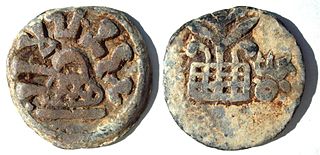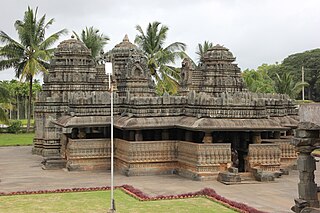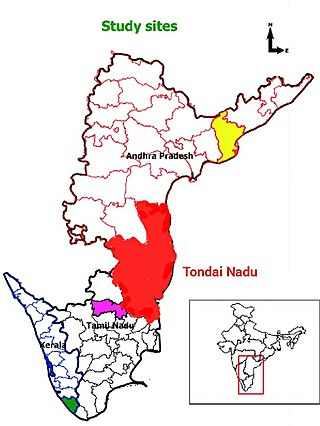
The Pallava dynasty existed from 275 CE to 897 CE, ruling a significant portion of the Deccan, also known as Tondaimandalam. The Pallavas played a crucial role in shaping the South Indian history and heritage during their rule. The dynasty rose to prominence after the downfall of the Satavahana dynasty, with whom they had formerly served as feudatories.

The Kadambas were an ancient royal family of Karnataka, India, that ruled northern Karnataka and the Konkan from Banavasi in present-day Uttara Kannada district. The kingdom was founded by Mayurasharma in c. 345, and at later times showed the potential of developing into imperial proportions. An indication of their imperial ambitions is provided by the titles and epithets assumed by its rulers, and the marital relations they kept with other kingdoms and empires, such as the Vakatakas and Guptas of northern India. Mayurasharma defeated the armies of the Pallavas of Kanchi possibly with the help of some native tribes and claimed sovereignty. The Kadamba power reached its peak during the rule of Kakusthavarma.

The Chutu dynasty ruled parts of the Deccan region of South India between first and third centuries CE, with its capital at Banavasi in present-day Karnataka state. The Chutus probably rose to power as Satavahanas feudatories, and assumed sovereignty after the decline of the Satavahana power. Except for the edicts of Asoka, the inscriptions of the Chutu dynasty are the oldest documents found in the northern part of Karnataka State, India.

The Telugu Chodas or Telugu Cholas ruled parts of present-day Andhra Pradesh and Telangana between the 6th and the 13th centuries as samantas of Pallavas and later the Cholas. Various dynasties exist among them including Velanati, Pottapi, Konidena, Nannuru, Nellore, Kunduru etc. The earliest Choda dynasty in the Telugu area was that of Renati Chodas who ruled Renadu region in the 6th and 7th centuries. Some of the Telugu Chodas including Renati Chodas claimed descent from the early Sangam Chola king Karikala Chola.Telugu Chodas contributed much to the early development of Telugu language and are the first dynasty to use Telugu as their official language. The first and oldest Telugu inscription founded so far is Kalamalla inscription dating to 575 CE put up by Renati Chola king Erikal Mutturaju Dhananjaya. Telugu Chodas are believed to have been migrated from Tamilakam to Andhra country due to invasion of Tamilakam by Kalabhras and increasing power of Pallavas in northern most part of Tamilakam.

North Karnataka is a geographical region in Deccan plateau from 300 to 730 metres elevation that constitutes the region of the Karnataka state in India and the region consists of 13 districts. It is drained by the Krishna River and its tributaries the Bhima, Ghataprabha, Malaprabha, and Tungabhadra. North Karnataka lies within the Deccan thorn scrub forests ecoregion, which extends north into eastern Maharashtra.

Chitradurga is a city and the headquarters of Chitradurga district, which is located on the valley of the Vedavati river in the central part of the Indian state of Karnataka. Chitradurga is a place with historical significance which is located to the North West about 200 km from the state capital Bengaluru. Chitradurga is a major tourist hub in Karnataka.

Rajendra Chola III came to the Chola throne in 1246 CE. Rajendra began to take effective control over the administration, and epigraphs of Rajendra Chola III indicate there was civil war ending with the death of Rajaraja Chola III. Rajendra's inscriptions laud him as the "cunning hero, who killed Rajaraja after making him wear the double crown for three years".

Balligavi a town in Shikaripura taluk Shivamogga district of Karnataka state, India, is today known as Belagami or Balagame. Its ancient names are Baligrama, Dakshina Kedara, Valliggame and Valligrame. Dakshina Kedara means Kedarnath of the South. A place of antiquity, it is known for its ancient monuments. Balligavi is located 72 km from Shivamogga city and 21 km from Shikaripura town and 2.3 km from Shiralakoppa in Shikaripura taluk. Balli in Kannada means creeper or vine.

The History of Karnataka goes back several millennia. Several great empires and dynasties have ruled over Karnataka and have contributed greatly to the history, culture and development of Karnataka as well as the entire Indian subcontinent. The Chindaka Nagas of central India Gangas, Rashtrakutas of Manyakheta, Chalukyas of Vengi, Yadava Dynasty of Devagiri were all of Kannada origin who later took to encouraging local languages.
Brahmagiri is an archaeological site located in the Chitradurga district of the state of Karnataka, India. Legend has it that this is the site where sage Gautama Maharishi and his wife Ahalya lived. He was one among seven noted Hindu saints. This site was first explored by Benjamin L. Rice in 1891, who discovered rock edicts of Emperor Ashoka here. These rock edicts indicated that the locality was termed as Isila and denoted the southernmost extent of the Mauryan empire. The Brahmagiri site is a granite outcrop elevated about 180 m. above the surrounding plains and measures around 500 m east-west and 100 m north-south. It is well known for the large number of megalithic monuments that have been found here. The earliest settlement found here has been dated to at least the 2nd millennium BC.
Kallur is an archaeological site and village located in the Manvi taluk of Raichur district in the state of Karnataka, India. It belongs to Gulbarga division. The site came into prominence with the discovery of antennae swords in the 1930s, which was the first instance of the Copper Hoard culture being discovered in South India. The earliest finding here has been dated to the Neolithic period.

Maski is a town and an archaeological site in the Raichur district of the state of Karnataka, India. It lies on the bank of the Maski river which is a tributary of the Tungabhadra. Maski derives its name from Mahasangha or Masangi. The site came into prominence with the discovery of a minor rock edict of Emperor Ashoka by C. Beadon in 1915. It was the first edict of Emperor Ashoka that contained the name Ashoka in it instead of the earlier edicts that referred him as Devanampiye piyadasi. This edict was important to conclude that many edicts found earlier in the Indian sub-continent in the name of Devanampiye piyadasi, all belonged to Emperor Ashoka. The edict is etched on a rock-face of Durgada-gudda, one of the gneissic outcrops that are present in the site.

The name Karnataka is derived from Karunadu, meaning "lofty land" or "high plateau," due to its location on the Deccan Plateau. The name can also mean "land of black soil" in Kannada. See other possible roots of the name. The recorded history of Karnataka goes back to the Ramayana and Mahabharata epics. The capital of "Baali" and "Sugriva" referenced in the Ramayana is said to be Hampi. Karnataka is mentioned in the Mahabharata as "Karnata Desha." Historically, the region was also called "Kuntala Rajya."

Tiruchirappalli is believed to be of great antiquity and has been ruled by the Early Cholas, Mutharaiyars Early Pandyas, Pallavas, Medieval Cholas, Later Cholas, Later Pandyas, Delhi Sultanate, Ma'bar Sultanate, Vijayanagar Empire, Nayak Dynasty, the Carnatic state and the British at different times. The archaeologically important town of Uraiyur which served as the capital of the Early Cholas is a Neighborhood of Tiruchirapalli.

The Kadambas of Halasi was a South Indian dynasty during the Late Classical period on the Indian subcontinent, which originated in the region of Halasi, Karnataka; who were known for their own style of temple building. The Kadamba dynasty was founded by Mayurasharma in about 4th century AD. It was believed that Mayura was the first king of the dynasty and was the ruler during the time of Pallava King Vishnugopa of Kanchipuram. After losing to North Indian Emperor Samudragupta, Vishnugopa’s army had weakened. Mayura seized the opportunity, formed his own army and drove away the Pallavas from Kannada territory. On reaching Chandravalli, Mayura took shelter in a cave and founded his own dynasty. Banavasi, near Sirsi, was their first capital and their rule extended to Gomantak or present day Goa.

About 25,000 inscriptions found in Karnataka and states near by belongs to Kannada rulers like Kadambas, Western Ganga Dynasty, Rashtrakuta, Chalukya, Hoysala and Vijayanagara Empire. Many inscriptions related to Jainism are unearthed. The inscriptions generally found are on stone (Shilashasana) or copper plates (Tamarashasana). The Kannada inscriptions found on historical Hero Stone, coin and temple wall, piller, tablet and rock edict. These Inscription have contributed towards Kannada literature and helped to classify as Proto Kannada, Pre Old Kannada, Old Kannada, Middle Kannada and New Kannada. Inscriptions depicts culture, tradition and prosperity of those era. The worldwide recognized literature Ramayana and Mahabharata are transferred through generation by these Inscription Hazara Rama Temple and Aranmula Parthasarathy Temple are the best example.
Bidar is a historic place located in the north-eastern part of the South Indian state of Karnataka. Bidar enjoys a picturesque situation, having been situated and built on the brink of a plateau, and thus commanding lovely views of the lowlands (talghat) towards the north and the east. Its latitude is 17°55'N., its longitude 77°32' E., and the height above the sea-level 2,330 feet (710 m). The climate is bracing and the temperature in the hottest season does not usually rise above 105 °F (41 °C). The Bidar plateau is an irregular oblong, 22 miles (35 km) in length and 12 miles (19 km) in extreme breadth.

Tondaimandalam, also known as Tondai Nadu, is a historical region located in the northernmost part of Tamil Nadu and southernmost part of Andhra Pradesh. The region comprises the districts which formed a part of the legendary kingdom of Athondai Chakravarti. The boundaries of Tondaimandalam are ambiguous – between the river basins of Penna River and Ponnaiyar River. During the reign of Rajaraja I, this region was called as Jayankonda Cholamandalam.

Archaeology in India is mainly done under the supervision of Archaeological Survey of India.

Mysore Hatti Krishna Iyengar was an Indian historian, archaeologist, epigraphist and authority in Indian numismatics. He pioneered the new field of Indology involving the study of Indian culture, history, music and traditions from a historical perspective. He is credited with the discovery of one of the oldest Kannada inscriptions, the Halmidi inscription, dating back to 350 A. D. He also discovered the remains of the city of Isila near Brahmagiri during his excavations at Chandravalli, Chitradurga. The forgotten tomb of Shahaji was traced by M. H. Krishna during his years at the Mysore Archaeological Department. His years at the Archaeology Department saw him churn out many of excavation reports and these were later published in successive volumes of Epigraphia Carnatica. During Krishna's tenure at Bangalore, he was instrumental in cataloguing close to 6000 coins in the archives of the archaeology department there. He was trained at the University College, London under Ernest Arthur Gardner. and would later accompany Sir Flinders Petrie in his excavations in Egypt.

















